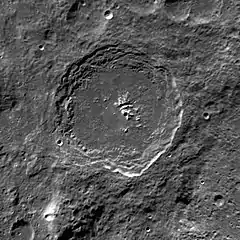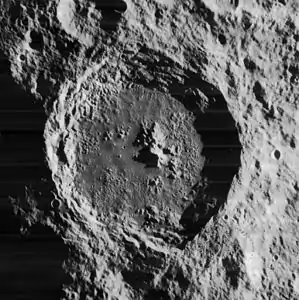 LRO image | |
| Coordinates | 65°07′S 88°29′W / 65.11°S 88.49°W |
|---|---|
| Diameter | 163.24 km |
| Depth | 3.9 km |
| Colongitude | 95° at sunrise |
| Eponym | Christian A. Hausen |


Hausen is a large lunar impact crater that lies along the south-southwestern limb of the Moon. It was named after German astronomer Christian A. Hausen by the IAU in 1961.[1]
The visibility of this crater is significantly affected by libration effects, although even under the best of conditions it is viewed nearly from on edge. It lies along the western edge of the immense walled plain Bailly. To the northeast is the crater Pingré on the near side, and to the north is the Arrhenius just on the far side of the lunar limb.
The rim of this crater is generally circular, with an outward bulge to the south-southeast. The inner wall is terraced at the northern and southern ends, and is more irregular along the eastern and western flanks. The rim along the east and southeast flanks displays slumping, producing a sharp edge. It is not significantly eroded or overlaid by craters, with only a single small craterlet along the southwest rim.
The interior floor is generally level, with a few sites of rough terrain. There is a complex formation of central peaks offset somewhat to the east of the midpoint. This formation extends further in the north–south direction and consists of several ridges separated by valleys. There is a lower range of hills just to the southeast of this range and a small cluster of hills to the south.
Hausen is the largest crater of Eratosthenian age.[2]
Hausen lies to the south of the Mendel-Rydberg Basin, a 630 km wide impact basin of Nectarian age.
Satellite craters
The following craters have been renamed by the IAU:
External links
- Hausen Crater Central Peaks, Oblique view from LRO
References
- ↑ "Hausen (crater)". Gazetteer of Planetary Nomenclature. USGS Astrogeology Research Program.
- ↑ The geologic history of the Moon. USGS Professional Paper 1348. By Don E. Wilhelms, John F. McCauley, and Newell J. Trask. U.S. Government Printing Office, Washington: 1987. Table 12.2.
- Andersson, L. E.; Whitaker, E. A. (1982). NASA Catalogue of Lunar Nomenclature. NASA RP-1097.
- Blue, Jennifer (July 25, 2007). "Gazetteer of Planetary Nomenclature". USGS. Retrieved 2007-08-05.
- Bussey, B.; Spudis, P. (2004). The Clementine Atlas of the Moon. New York: Cambridge University Press. ISBN 978-0-521-81528-4.
- Cocks, Elijah E.; Cocks, Josiah C. (1995). Who's Who on the Moon: A Biographical Dictionary of Lunar Nomenclature. Tudor Publishers. ISBN 978-0-936389-27-1.
- McDowell, Jonathan (July 15, 2007). "Lunar Nomenclature". Jonathan's Space Report. Retrieved 2007-10-24.
- Menzel, D. H.; Minnaert, M.; Levin, B.; Dollfus, A.; Bell, B. (1971). "Report on Lunar Nomenclature by the Working Group of Commission 17 of the IAU". Space Science Reviews. 12 (2): 136–186. Bibcode:1971SSRv...12..136M. doi:10.1007/BF00171763. S2CID 122125855.
- Moore, Patrick (2001). On the Moon. Sterling Publishing Co. ISBN 978-0-304-35469-6.
- Price, Fred W. (1988). The Moon Observer's Handbook. Cambridge University Press. ISBN 978-0-521-33500-3.
- Rükl, Antonín (1990). Atlas of the Moon. Kalmbach Books. ISBN 978-0-913135-17-4.
- Webb, Rev. T. W. (1962). Celestial Objects for Common Telescopes (6th revised ed.). Dover. ISBN 978-0-486-20917-3.
- Whitaker, Ewen A. (1999). Mapping and Naming the Moon. Cambridge University Press. ISBN 978-0-521-62248-6.
- Wlasuk, Peter T. (2000). Observing the Moon. Springer. ISBN 978-1-85233-193-1.